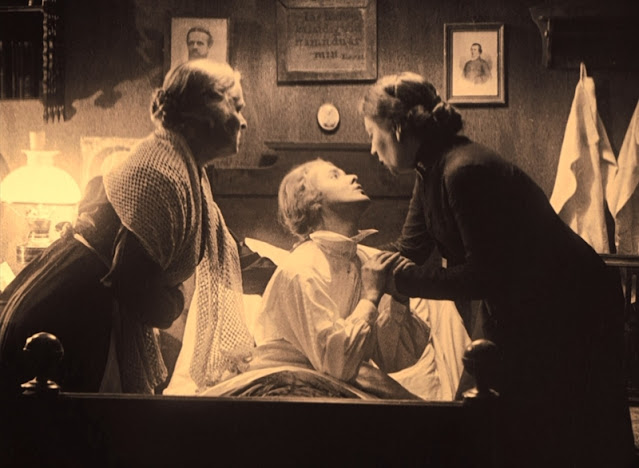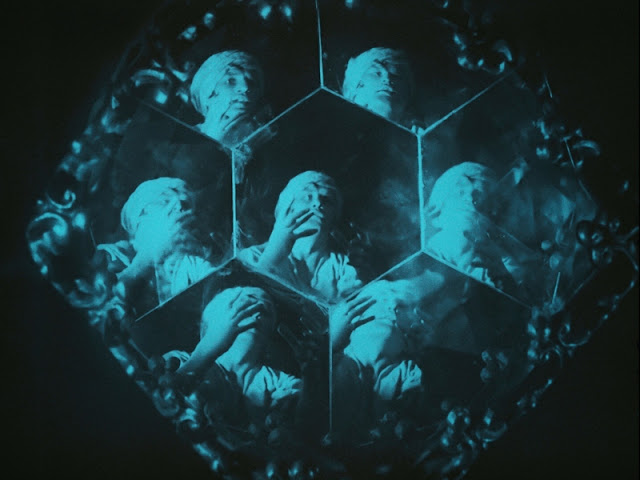(1921) Directed by Victor Sjöström; Written by Victor Sjöström; Based on the novel by Selma Lagerlöf; Starring: Victor Sjöström, Hilda Borgström, Tore Svennberg, Astrid Holm and Concordia Selander; Available on Blu ray and DVD
Rating: ****½ stars
“No living soul rides in that carriage. By the time I
arrive, it’s too late for a doctor. You know full well that I am no longer
among the living. But worst of all, you must face the consequences of the evil
you have wrought during your lifetime.” – Georges (Tore
Svennberg)
What sort of legacy will we leave behind for our loved ones? Will they think of us with reverence or disdain? We’ve all done things we’re not proud of, but at the end of our lives, when the scales are measured, ideally, the good we’ve accomplished should outweigh the questionable deeds. Director/screenwriter/star Victor Sjöström addresses these questions and more in The Phantom Carriage, based on Selma Lagerlöf’s 1912 novel Körkarlen (aka: Thy Soul Shall Bear Witness!), part of a collaboration between Sjöström and the author that would span five films.
In the opening scene, Edit (Astrid Holm) lies on her deathbed on New Year’s Eve, asking for David Holm (Victor Sjöström) to visit. In the following scene, Holm drunkenly celebrates with his companions in a graveyard, telling stories to keep warm. He relates the tale that sets the rest of the plot in motion – whoever dies at the stroke of midnight on New Year’s Eve is destined to drive Death’s ghostly carriage, armed with a scythe to reap the souls of the dead, for the following year, with no reprieve or days off. After a scuffle with one of his friends, David perishes at midnight, coming face to face with the legendary carriage and its driver, Georges (Tore Svennberg), who passed away the previous New Year’s Eve. Before Holm takes his place, Georges makes his bewildered replacement re-experience three pivotal moments (told in flashback) when his life took a wrong turn. In the first flashback, we see how Holm turned away from his family and embraced alcoholism.* After being jailed for public drunkenness, he’ released, only to return to an empty house. Instead of reflecting on his wretched behavior, he vows revenge against his wife (Hilda Borgström) for abandoning him. Thus follows Holm’s personal journey, running the gamut of emotion from anger, disgust, guilt, self-loathing, and ultimately redemption.
* Fun Fact #1: The Phantom Carriage was co-opted by proponents
of the temperance movement in several countries, to illustrate the evils of
alcohol abuse.
At the heart of The Phantom Carriage is Sjöström’s nuanced performance. Seemingly bereft of the capacity for self-reflection, Holm blames his sorrows on his wife. He descends into an abyss of bitterness and hatred, immune to others’ overtures of compassion and charity. In the second flashback, set during the previous New Year’s Eve, he visits a Salvation Army shelter, where he captures the eye of Sister Edit (Astrid Holm). While he sleeps, she thoughtfully repairs his tattered coat, despite warnings from her colleague that it’s covered in germs and filth (a decision that will ultimately cause her death). She cheerfully returns the repaired garment to Holm, only for him to callously render it apart. She later visits him in a bar, where he’s only grown more bitter with time (“Why turn away so carefully? I’m a consumptive, myself, but I cough in people’s faces in hopes of finishing them off. Why should they be better off than us?”). When he discovers the whereabouts of his wife and children, their reunion is less than conciliatory (while she appears ready to pick up where they left off, he fiercely holds on to his wife’s perceived betrayal). When she attempts to lock herself and the children away from Holm, he hacks through the door with an axe* (In an act of spitefulness, he subsequently attempts to infect his own children). Eventually faced with his own mortality, David begs the carriage driver for forgiveness and a second chance. While it’s difficult to excuse his antisocial behavior, our portrait of David Holm is far from one-sided. We also witness his capacity for love and kindness in a flashback with his family, and when he returns as a spirit to comfort Edit in her final moments.
* Fun Fact #2: Film historian Casper Tybjerg claims this memorable
scene (copied years later by Stanley Kubrick in his version of The Shining)
may have been influenced by a similar sequence in Broken Blossoms (1919).
If David Holm personifies selfishness, then Sister Edit* represents his polar opposite. Rather than seeing Holm’s rejection of her charity as an irredeemable act, she views him as a challenge. Despite all indications to the contrary, she never gives up faith in his ability to find redemption. While there are indications that her motivations are not completely selfless, her feelings for him give way to seeing that his marriage is repaired. In an act of misguided good intentions, she reunites David with his family, with disastrous results.
* Her deathbed scenes seem to prefigure Harriet Andersson’s
scenes as Agnes in Ingmar Bergman’s Cries and Whispers (1972).
The ghostly image* of the carriage rolling through the city streets, pulled by a skeletal horse, ranks among some of the most haunting imagery of silent (and talkie) cinema. A particularly indelible sequence depicts the driver retrieving a soul from a drowned sailor on the ocean floor (A possible influence for a scene in Night of the Hunter?). It’s a testament to the skill of the filmmakers** that more than 100 years later, we remain mesmerized by these images. Another factor that contributes heavily to the gloomy atmosphere is that most of the film takes place in the evening. Despite the inherent lighting challenge with film equipment of the time, Sjöström insisted on night-for-night shooting.
* Fun Fact #3: Although commonly referred to as “double exposure” some of the in-camera effects shots required the film to pass through the camera as many as four times.
** Fun Fact #4: Writing about the production at the time
(specifically Julius Jaenzon’s cinematography) Sjöström commented, “We were
proud of the ghosts’ consistency. They were actually not flat and misty. As a
result of artful lighting, they had become three-dimensional in their
spirituality.”
Is David Holm beyond redemption? It depends on your point of view. Nothing could undo the damage he inflicted on several lives, but it’s significant that he comes to a realization of his culpability at the moment of his death. Whether he’s virtuous or evil (or somewhere in-between, like most of us), Holm is still doomed to drive the phantom carriage. Perhaps it’s a matter of perspective – to be resigned to one’s fate instead of feeling shackled by it. While The Phantom Carriage received glowing reviews upon its release (Charlie Chaplin and Ingmar Bergman ranked among its many fans) it fell out of favor with critics in the ‘30s, with some accusing the film as being too naïve and moralistic, and its double-exposure shots as passé, time has vindicated Victor Sjöström and his remarkable film. Sjöström used every tool available to tell his story, and it shows. The Phantom Carriage encourages the viewer to turn inward and confront their virtues and failings. If we see a little of ourselves in each of the film’s characters, the resemblance is far from incidental.
Sources for this article: Criterion Blu-ray commentary by Casper
Tybjerg; Victor Sjöström: His Life and His Work, by Bengt Forslund
(1988)























